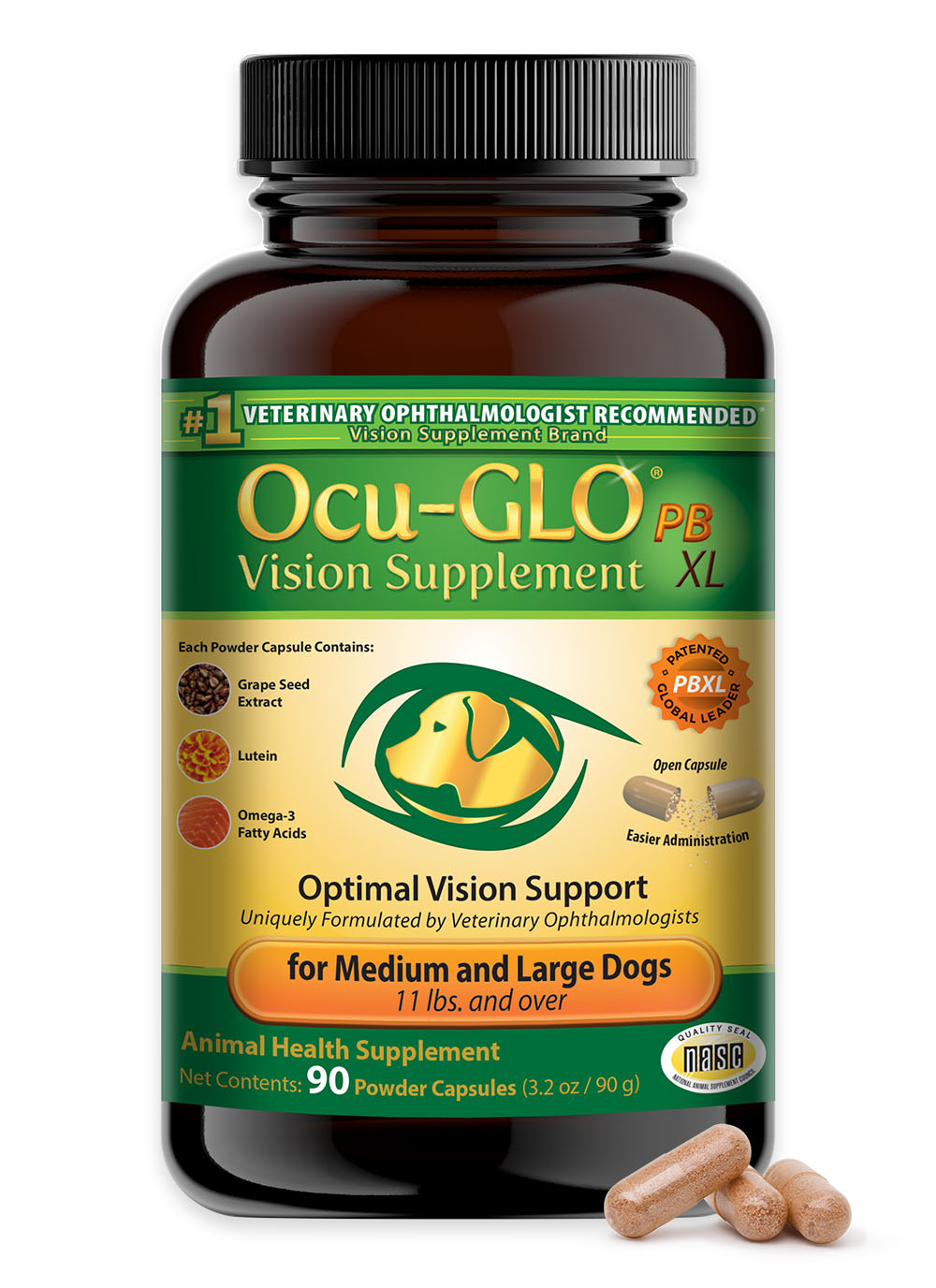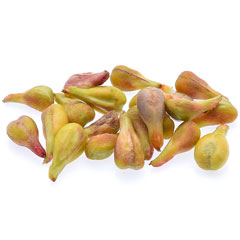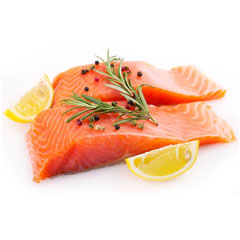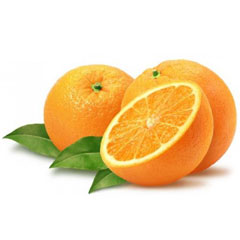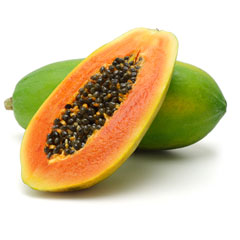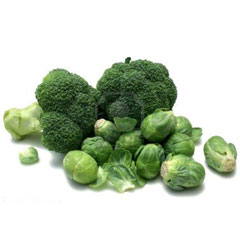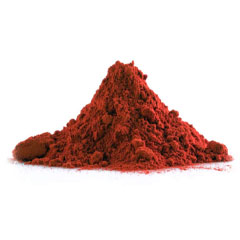
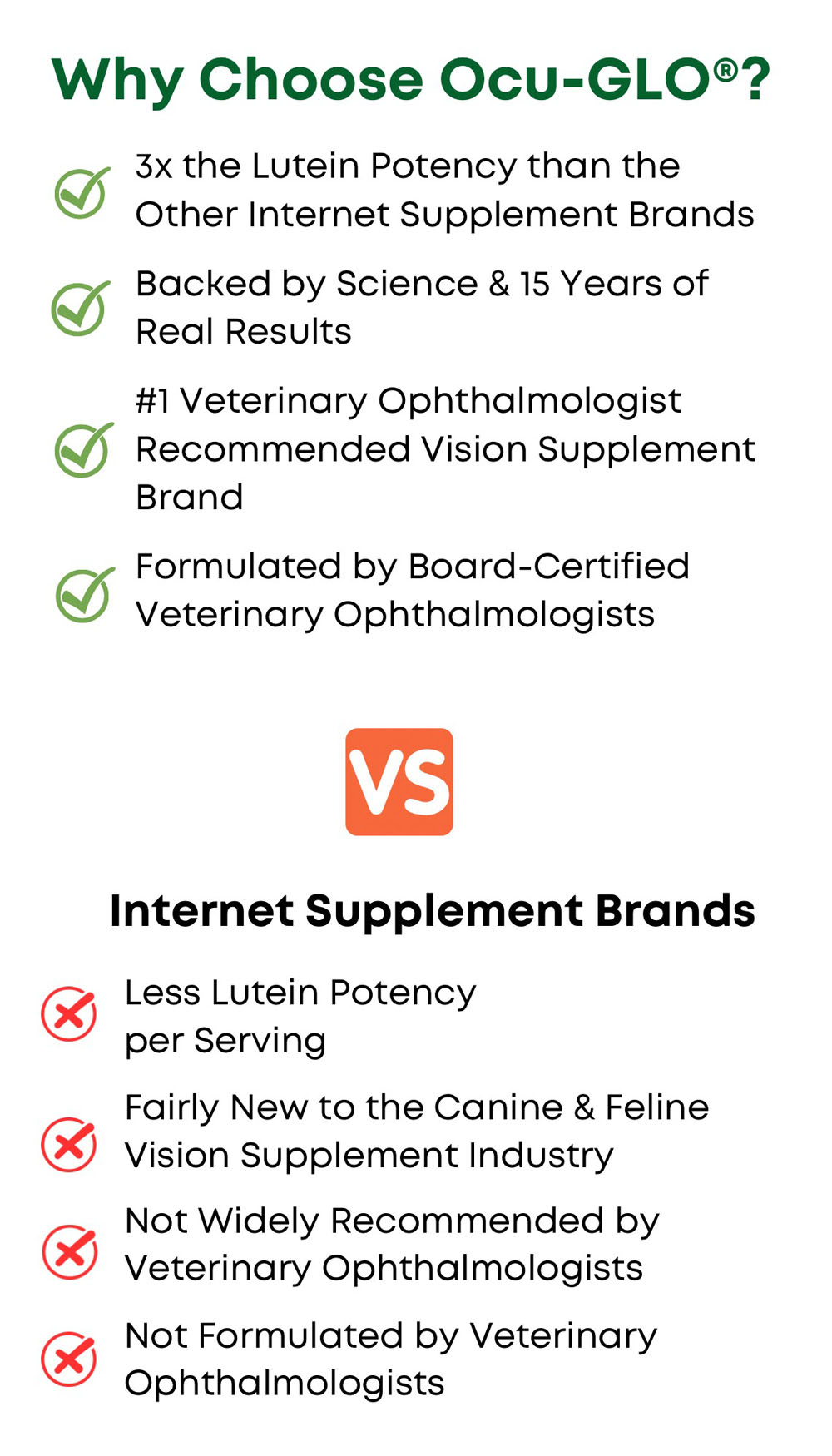
How does Ocu-GLO® Powder Blend (PB) XL differ from Ocu-GLO® Gel-Caps?
- Our powder form is easier to mix versus regular Ocu-GLO® Gel-Caps - just open the capsule and sprinkle!
- Easier administration at mealtime for medium and large dogs
- Formulated by board certified veterinary ophthalmologists
- Includes GLO® for optimal vision health: Grape seed extract, Lutein and Omega-3 fatty acids
- Specifically formulated to support canine eyes
- Optimal for pets with sensitive GL tracts
- Astaxanthin for enhanced antioxidant support
- For use in dogs and cats 6 months or older, and cats weighing 5lbs or more. Do not use in cats with a history of liver disease.
Ocu-GLO® also:
- Contains 3Xs the Lutein/antioxidant potency of the other internet supplement brands
- Has no synthetic colors
- Has no harmful or unwanted preservatives
- Is made in the USA from US and globally sourced ingredients
Some of our canine friends have always been extremely hard to pill. With Ocu-GLO® PB XL, it's very easy to give them the supplement they need! Simply crack open the capsule and sprinkle the powder. Our new formula is great tasting and will go down easily the first time.
Have a question about Ocu-GLO®? Please visit our Frequently Asked Questions and the Ocu-GLO® official website!
Download the Material Safety Data Sheet for Ocu-GLO® Capsules here!
Store this product in a cool, dry place (59 - 86 degrees Fahrenheit / 15 - 30 degrees Celsius).
Ocu-GLO® is formulated with different antioxidants that work to support eye health through the quenching of reactive oxygen species (ROS). These active ingredients include:
- GLO® Proprietary Blend
- Grape seed extract: Grape seed extract contains different proanthocyanidins such as: catechin, epicatechin and gallic acid, which work to inhibit key components of reactive oxygen species production and stress induced cell signaling in the canine lens epithelium.1
- Lutein: Lutein is a carotenoid that has a large body of evidence that supports its antioxidant activity in the eye. Lutein deficiency has been associated with an increased risk of age-related macular degeneration.2 Lutein supplementation also increases lymphocyte proliferative response and the expression of major hiscompatability complex II (MHC II).3
- Omega-3 fatty acids: Omega-3 fatty acids, in the form of eicosapentaenoic acid (EPA) and docosahexaenoic acid (DHA), regulate the inflammatory response, vascular death and regeneration, and photoreceptor apoptosis (cell death) in the eye. A decrease in DHA has been associated with an increase in cytokine-induced proinflammatory signaling in the retina. An increase in both EPA and DHA have been shown to reduce blood vessel damage and hypoxic injury after a retinal insult, as well as reduce photoreceptor apoptosis.4
- Vitamin C: Vitamin C, in the form of ascorbic acid, is a water soluble vitamin and antioxidant that is vital to the healing process. It is required for neutrophil apoptosis and clearance, and contributes towards collagen synthesis, maturation, secretion, and degradation.5
- Green tea leaf extract: Green tea leaf extract is a great source of antioxidants that have been credited with a range of health benefits. Green tea leaf extract contains catechins that have been shown to regulate the inflammatory response in the eye from infectious, non infectious, and oxidative complications.6
- Vitamin E: Vitamin E refers to a group of fat-soluble compounds. Supplementation of one of these compounds, α-tocopherol, attacks free radicals to prevent lipid oxidation in retina and other body tissues.7,8
- Alpha Lipoic Acid: Alpha Lipoic Acid, or ALA, is an essential cofactor for the synthesis of glutathione, the body’s most potent endogenous antioxidant. ALA and glutathione both work to scavenge free radicals to protect the lens from oxidative stress.9
- Coenzyme Q10: Coenzyme Q10, or CoQ-10, is a naturally occurring quinone found in most organisms. CoQ-10 is essential for the health of virtually all tissues since it is involved with the production of adenosine triphosphate (ATP). Decreases in CoQ-10 have been linked to the development diseases that result in an increase in reactive oxygen species (ROS), as its antioxidant activity helps prevent modifications of proteins and DNA by ROS.10
- Zinc: Zinc is a mineral that has potent antioxidant activity. Zinc can help protect membranes from iron-initiated lipid oxidation while working synergistically with other antioxidants.11
- Vitamin B1 (Thiamin HCl): Vitamin B1 is important for neuromuscular development and aids in cellular metabolism.
- Vitamin B3 (Niacin): Vitamin B3 may help lower serum triglyceride, cholesterol, low density lipoprotein, and very low density lipoprotein levels in the blood.
- Vitamin B5 (d-calcium Pantothenate): Vitamin B5 is essential for the breakdown of fatty acids, amino acids, steroids, and cholesterol. Vitamin B5 also functions as an antioxidant.
- Vitamin B6 (Pyridoxine HCl): Vitamin B6 helps with hemoglobin formation as well as the metabolism of fats, carbohydrates, and proteins.
- Vitamin B7 (Biotin): Biotin is an enzyme cofactor involved in the metabolism of amino acids and the biosynthesis of fats and carbohydrates.
- Vitamin B9 (Folic Acid): Vitamin B9 is important for cell growth and development.
- Vitamin B12 (Cyanocobalamin): Vitamin B12 is an enzyme cofactor that is essential for cell growth and red blood cell development.
References
1. Barden CA, Chandler HL, Lu P, Bomser JA, Colitz CMH. 2008. Effect of grape polyphenols on oxidative stress in canine lens epithelial cells. Am J Vet Res 69(1):94-100.
2. Bernstein PS, Zhao DY, Wintch SW, Ermakov IV, McClane RW, Gellermann W. 2002. Resonance raman measurement of macular carotenoids in normal subjects and in age-related macular degeneration patients. Ophthalmology 109(10):1780-1787.
3. Kim HW, Chew BP, Wong TS, Park JS, Weng BB, Byrne KM, Hayek MG, Reinhart GA. 2000. Dietary lutein stimulates immune response in the canine. Vet Immunol Immunopathol 74(3-4):315-327.
4. Querques G, Forte R, Souied ER. 2011. Retina and omega-3. J Nutr Metab 2011:748361.
5. Moores J. 2013. Vitamin C: a wound healing perspective. Br J Community Nurs: S8-S11.
6. Li J, Du L, He JN, Chu KO, Guo CL, Wong MOM, Pang CP, Chu WK. 2021. Anti-inflammatory effects of GTE in eye diseases. Front Nutr 8:753955.
7. Mejia-Fava J, Colitz CMH. 2014. Supplements for exotic pets. Vet Clin Exot Anim 17:503-525.
8. Rasmussen HM, Johnson EJ. 2013. Nutrients for the aging eye. Clin Interv Aging 8:741-748.
9. Mandelker L, Wynn S. 2004. Cellular effects of common nutraceuticals and natural food substances. Vet Clin Small Anim 34: 339-353.
10. Saini R. 2011. Coenzyme Q10: the essential nutrient. J Pharm Bioallied Sci 3(3):466-467.
11. Zago MP, Oteiza PI. 2001. The antioxidant properties of zinc: interactions with iron and antioxidants. Free Radic Biol Med 31(2):266-274.
Open capsule for easier administration and give at mealtime. If daily suggested use is more than one capsule, divide up to give during multiple meals. Store tightly sealed in a cool dry place. For use in dogs and cats 6 months or older, and cats weighing 5lbs or more. Do not use in cats with a history of liver disease.
Warning: For animal use only. Keep out of reach of children and animals. In case of accidental overdose, contact a health professional immediately.
